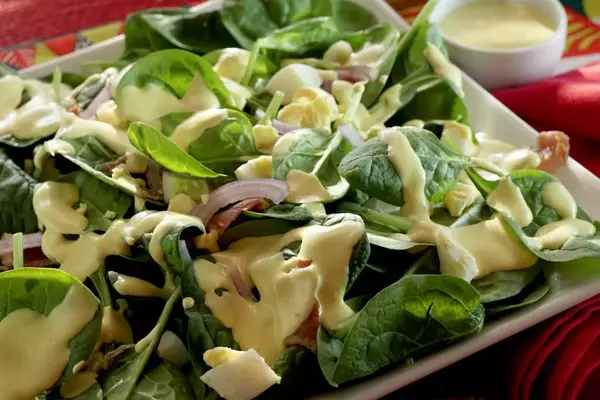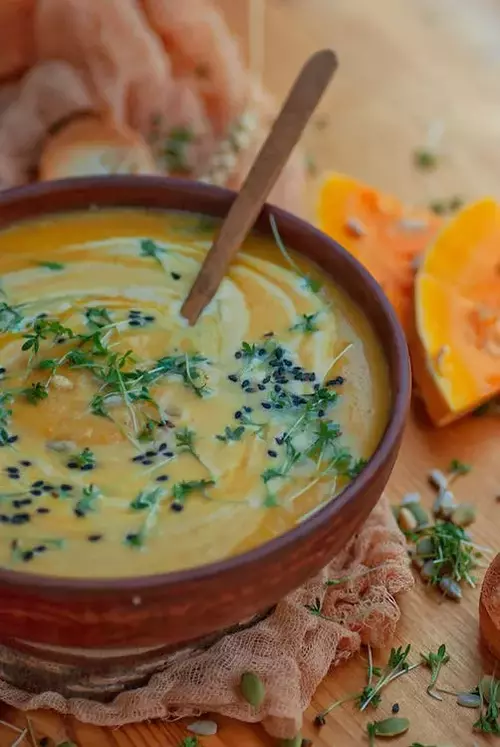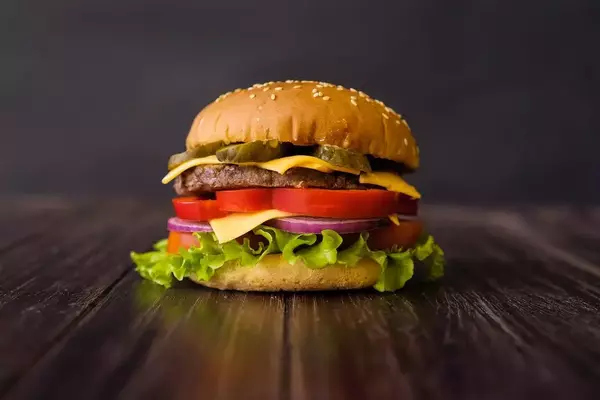Salt is an essential ingredient in our diet as it helps to flavor our food and enhance its taste. However, consuming too much salt can lead to several health problems such as high blood pressure, heart disease, and stroke.
Unfortunately, many of us are unaware of the salt content in the foods we eat, and we end up consuming more than the recommended daily intake.
Here we will be discussing the top 10 foods that are high in salt so that you can make informed decisions about your diet and keep your salt intake in check. So, let’s dive in and discover some surprising foods that are loaded with sodium!
1. Salad Dressing
Salad dressings are a staple in many people’s diets, but did you know that they can also be one of the top sources of sodium? It’s true – some salad dressings can have up to 500mg of sodium in just two tablespoons! But don’t worry, there are healthier options out there.
One of the best low-sodium salad dressings on the market is Primal Kitchen’s Greek Vinaigrette. Made with high-quality ingredients like avocado oil and organic apple cider vinegar, this dressing only has 95mg of sodium per serving. Plus, it’s free of any artificial preservatives or sweeteners.
Another option is Brianna’s Home Style Real French Vinaigrette. This dressing has a tangy and delicious flavor, but only has 105mg of sodium per serving. It’s made with simple ingredients like garlic, dijon mustard, and sunflower oil, and is perfect for topping off a crunchy salad.

If you prefer to make your own dressing at home, try mixing together olive oil, lemon juice, and herbs like basil or oregano. This will give you a light and refreshing dressing that’s free of any added sodium.
2. Slices of Cured Meats
When it comes to high sodium foods, cured meats like ham, cold cuts, jerky, and hot dogs are right near the top of the list. In just 2 oz of ham (5 to 6 slices), there can be up to 470 mg of sodium. That’s a significant amount, and it’s even worse when eating multiple servings throughout the day.
The problem with cured meats is that they are highly processed and tend to be loaded with not just sodium, but also preservatives and other additives that are not so great for the body. That doesn’t mean you need to give up your favorite deli sandwich, though.
When shopping for cured meats, it’s always best to look for lower sodium options or even no salt added versions. Many grocery stores and delis offer low sodium ham and turkey that are just as tasty as the regular versions. And if you’re really committed to cutting back on processed foods, consider making your own roast beef or turkey breast at home.
3. Biscuits with Sausage
While these breakfast favorites may be undeniably tasty, they are also one of the saltiest items on our list, with an average of 415 mg of sodium per 2-ounce serving.
But don’t worry, there are still ways to enjoy this classic combo without sacrificing your health. While some pre-packaged biscuits and sausage options may be loaded with salt, there are plenty of homemade and low-sodium alternatives available.
For those looking for a quick and easy breakfast option, opt for whole wheat biscuits and turkey sausage, which have significantly less sodium than their white flour and pork counterparts. And for those with a little extra time, making your own homemade biscuits and sausage from scratch can also be a healthier and more delicious option.
4. Canned Soup
Canned soup is a convenient and easy meal option, but it’s important to be aware of its high sodium content.

For those who prefer a wider variety of soup options, Pacific Foods offers a range of low sodium canned soups. It’s important to read the nutrition labels carefully and choose soups with less than 20% of the daily value of sodium per serving.
5. Deli Meat
Deli meat may seem like a quick and easy lunch option, but it can be packed with salt. Just one slice of ham, for example, can contain around 291 mg of sodium.
For those trying to cut back on their salt intake, deli meat is certainly a good place to start. Sliced turkey also tends to be higher in sodium than roast beef or chicken, depending on the preparation. It’s best to opt for lower-sodium brands or to make your own lunch meats at home.
When it comes to convenient foods, it’s important to be mindful of sodium content. Other top sources of sodium include canned soup, boxed meals, and frozen meals. Pretzels may seem like a healthier snack option, but they’re also high in salt. Pizza and biscuits with sausage can also pack a sodium punch.
One way to combat the high salt content in these foods is to incorporate more fresh fruits and vegetables into meals. Cottage cheese, for example, is a good source of calcium and a lower-sodium option. Grapefruit brûlée is a tasty and healthy dessert alternative.
6. Boxed Meals
Looking at the list of top 10 foods high in salt, it’s hard not to feel discouraged. But fear not, dear reader, as there are ways to still enjoy your meals while watching your sodium intake. One way is to opt for low-sodium versions of pre-packaged meals, like boxed meals.
Boxed meals are a convenient option for busy individuals and families, as they can be quickly prepared and require little effort. However, many boxed meals are also high in sodium, with some containing up to 1,300 mg per serving. This is a significant amount considering the recommended daily intake of sodium is 2,300 mg for adults, and even lower for those with hypertension or other health conditions.
What’s a hungry person to do? Look for low-sodium options, of course! Many brands now offer low-sodium alternatives to their boxed meals, which can be found in the same section of the grocery store. These low-sodium meals may have around 500 mg or less of sodium per serving, which is much more manageable.
It’s important to read food labels when selecting boxed meals, as some brands may use sneaky language like “reduced sodium” or “low sodium” when the actual sodium content is still quite high. Always aim to choose meals with less than 500 mg of sodium per serving, and consider adding fresh herbs and spices to enhance the flavor.
7. Frozen Meals
Frozen meals are a popular option for those who want a quick and easy meal, but they can often be packed with sodium. Many frozen meals are loaded with preservatives and are high in salt, making them a potential health risk for those who consume them on a regular basis.
When it comes to frozen meals, it’s important to check the labels and be aware of what you’re consuming. There are some frozen meal options that are healthier than others, so it’s important to do a little research and choose wisely. For example, frozen meals that contain fresh ingredients, such as vegetables and lean meats, are typically healthier than those that contain processed meats and cheeses.
Some frozen meal options that are lower in sodium include those from brands like Amy’s Kitchen, Evol, and Luvo. These brands offer frozen meals that are made with natural ingredients and are lower in salt. Additionally, many grocery stores now offer their own brand of healthier frozen meals that are low in sodium and high in nutritional value.
8. Pretzels
Moving on to the eighth item on our list of high-sodium foods: pretzels. These savory snacks are a popular choice for a quick bite or a party snack, but they pack a serious sodium punch. A single serving of pretzels can contain up to 500 milligrams of sodium!
While pretzels may be a tasty treat, it’s important to keep in mind their high sodium content. If you just can’t resist the crunch of a pretzel, consider opting for a low-sodium variety or limiting your serving size.
9. Pizza
Moving on to the number 9 spot on the list of top 10 high-sodium foods, we have the beloved pizza. But before you swear off pizza forever, it’s important to understand why it made the list.

Pizza, whether it’s from a restaurant or store-bought, contains a lot of salt in both the crust and toppings. One slice can have up to 900 milligrams of sodium or more. And let’s be honest, who stops at one slice?
But fear not, pizza lovers. There are ways to still enjoy your favorite food without overloading on sodium. Opt for toppings like vegetables, chicken, or shrimp instead of high-sodium meats like pepperoni or sausage. Choose a thinner crust or even a cauliflower crust option to cut down on the salt. And when ordering from a restaurant, ask for less cheese, which can also be high in sodium.
10. Pickles
Pickles are a beloved addition to many meals, but they can also be a major source of sodium in your diet. While they are tasty, it’s important to be mindful of how much sodium you’re consuming when enjoying pickles.
As mentioned in the previous sections, pickles are high in sodium, but they also have some gut-healthy properties that make them a great addition to your diet. If you can’t live without your pickles, it’s recommended to rinse them in water before eating to reduce some of the sodium on the outside.
There are also low-sodium pickles available on the market that may be a good option for those looking to reduce their salt intake. It’s important to read labels and compare sodium content across different brands to find the best option for you.
Salty Foods vs. Your Health
See what health problems can arise if you overindulge in the consumption of salty foods:
- Elevated risk of heart disease: Eating too much salt elevates a person’s risk of heart disease, which is the leading cause of death worldwide.
- Increased blood pressure: A high salt diet may lead to an increase in blood pressure, a major risk factor for heart attacks and stroke.
- Kidney problems: Excessive salt intake can negatively affect kidney function and cause kidney disease or kidney stones.
- Stomach cancer: Long-term consumption of high salt diets may increase the risk of stomach cancer.
- Enlarged heart muscle: Consuming too much salt may cause the heart muscle to become enlarged, leading to heart failure or other cardiac problems.
- Headaches: Some people may experience headaches after consuming a salty meal, which may be due to dehydration caused by excess sodium.
- Water retention & bloating: Excess sodium intake can cause water retention and bloating, making a person feel uncomfortably full.
- Risk of strokes: High blood pressure, caused by a high salt diet, increases a person’s risk of strokes, which can cause permanent damage to the brain.
- Dehydration: Consuming too much salt can cause dehydration, leading to symptoms such as thirst, dry mouth, and fatigue.
- Short-term and long-term effects: While some effects of excess salt intake may be short-lived, such as bloating or thirst, the long-term consequences can be serious and even life-threatening.
It is crucial to monitor salt intake and strive to keep it within the recommended daily limits to maintain optimal health. Simple changes like avoiding processed foods or reducing salt in cooking can have significant impacts on one’s overall well-being.

About the Author
Reyus Mammadli is the author of this health blog since 2008. With a background in medical and biotechnical devices, he has over 15 years of experience working with medical literature and expert guidelines from WHO, CDC, Mayo Clinic, and others. His goal is to present clear, accurate health information for everyday readers — not as a substitute for medical advice.







